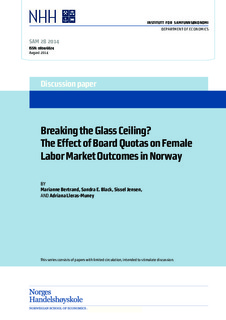| dc.description.abstract | In late 2003, Norway passed a law mandating 40 percent representation of each gender on the
board of publicly limited liability companies. The primary objective of this reform was to
increase the representation of women in top positions in the corporate sector and decrease gender
disparity in earnings within that sector. We document that the newly (post-reform) appointed
female board members were observably more qualified than their female predecessors, and that
the gender gap in earnings within boards fell substantially. While the reform may have improved
the representation of female employees at the very top of the earnings distribution (top 5 highest
earners) within firms that were mandated to increase female participation on their board, there is
no evidence that these gains at the very top trickled-down. Moreover the reform had no obvious
impact on highly qualified women whose qualifications mirror those of board members but who
were not appointed to boards. We observe no statistically significant change in the gender wage
gaps or in female representation in top positions, although standard errors are large enough that
we cannot rule economically meaningful gains. Finally, there is little evidence that the reform
affected the decisions of women more generally; it was not accompanied by any change in female
enrollment in business education programs, or a convergence in earnings trajectories between
recent male and female graduates of such programs. While young women preparing for a career
in business report being aware of the reform and expect their earnings and promotion chances to
benefit from it, the reform did not affect their fertility and marital plans. Overall, in the short run
the reform had very little discernible impact on women in business beyond its direct effect on the
newly appointed female board members. | nb_NO |
